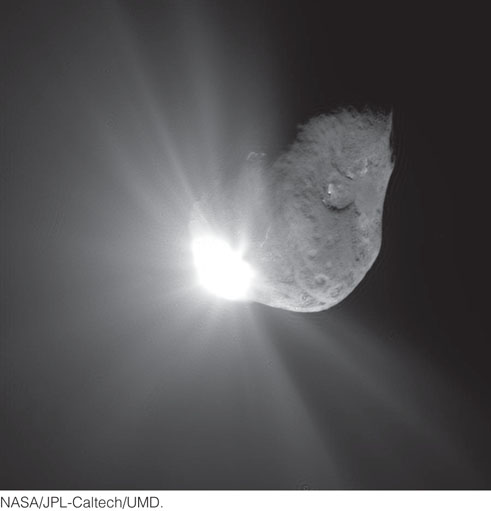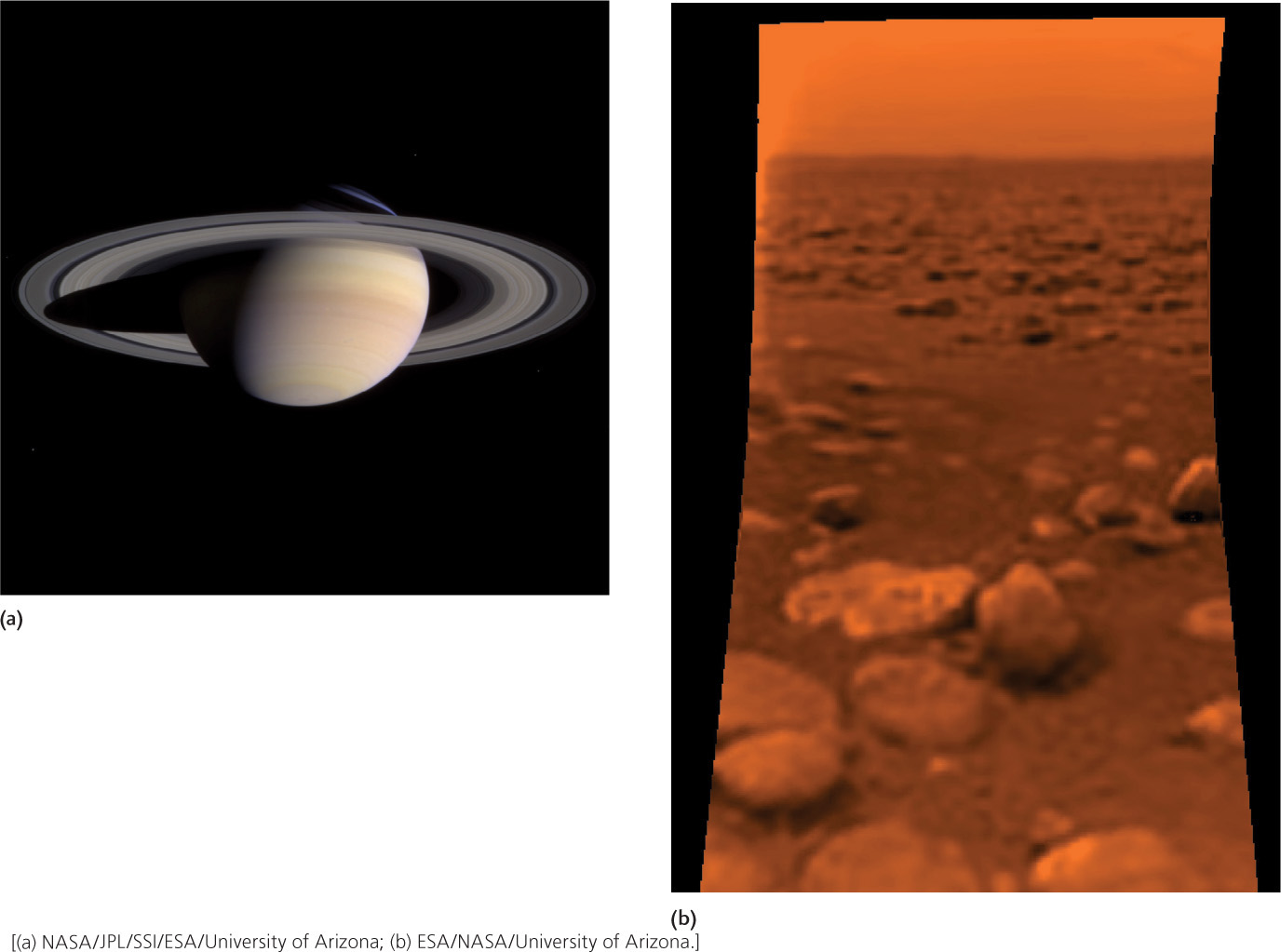Exploring the Solar System and Beyond
An astronomer staring through a telescope is the first image that comes to mind when most people think of exploring the solar system. But most modern telescopes have no eyepiece at all, and instead record their images with digital cameras. Many telescopes, such as the Hubble Space Telescope, are not even located on Earth, but are positioned in space.
Regardless of how a telescope takes its photographs or where it is stationed, its purpose is the same: to gather more light than we can with the naked human eye. Its photographs can be processed to increase their brightness further or enhance their contrast; such techniques can reveal important planetary surface features such as craters and canyons. All the geologic surface features of the planets discussed so far in this chapter have been studied in this way.
However, the light gathered by telescopes and digital cameras such as those on Spirit and Opportunity can also be studied using a second technique. Once we have a record of the light coming from an object of interest—say, a planet, a star, or an outcrop—we can study its spectrum. We are all familiar with how sunlight, when passed through a prism, splits into a rainbow of colors called its spectrum (plural spectra). The light generated by a star, or reflected off the surface of a planet or outcrop, also produces a spectrum. The colors of that spectrum can reveal the chemical composition of the light-producing or light-reflecting materials. Thus, geologists can look at the spectrum of light reflected from a planet and know which gases are in its atmosphere and which chemicals and minerals are in its rocks and soils.
Astronomers use this same principle to look at the light coming from faraway stars and galaxies. The spectra they see tell them the ages of those stars and galaxies, reveal how they evolved, and even provide mind-boggling insights into the origin and evolution of the universe.
Space Missions
Most observations of our solar system and beyond are still made from Earth. Over the past 50 years, however, we have sent all kinds of machines, robots, and even humans into space in our quest to explore the unknown. Space missions are a costly business, requiring a tremendous effort by hundreds and sometimes thousands of people at a cost of hundreds of millions to billions of dollars. The Mars Exploration Rovers mission cost on the order of $800 million for both rovers, and Mars Science Laboratory—about the size of a car—cost over $2 billion. And space missions are a risky business: fewer than half the missions sent to Mars have succeeded. As the space shuttle program reminds us, space exploration is risky for humans, too.
Are these efforts, costs, and risks worth it? For thousands of years, people have looked up at the skies and pondered the universe. What are the stars and planets made of? How did the universe form? Is there any life out there? To answer these questions, we have to look for clues, and most of those clues will be provided only by missions to space. The issue is not so much whether or not to explore space, but how. Most debates focus on whether it is essential to send humans into space or whether the Mars rovers missions have demonstrated the adequacy of robots.
We are actively exploring space in many different ways. Spacecraft have been sent to orbit planets, moons, and asteroids and to fly by planets and comets in the outer solar system and beyond. On other occasions, we have instructed landers and other probes to descend to planetary surfaces and make direct measurements of rocks, minerals, gases, and fluids. On July 3, 2005, a probe was released from the Deep Impact spacecraft and instructed to collide deliberately with the comet Tempel 1. The depth of the resulting crater and the light emitted at the time of the collision (Figure 9.29) revealed what the interior of the comet is made of. The comet was found to consist of a mixture of dust and ice; the dust component included clay, carbonate, and silicate minerals and was enriched in sodium, which is rare in space.
246

The Cassini-Huygens Mission to Saturn
An even more remarkable story of deep space exploration involves the Cassini-Huygens mission. In 2005, the Huygens lander became the farthest-traveled spacecraft to reach another planet and “live” to tell about it.
Cassini-Huygens is one of the most ambitious missions ever launched into space. The Cassini-Huygens spacecraft includes two components: the Cassini orbiter and the Huygens lander. The spacecraft was launched from Earth on October 15, 1997. After traveling over a billion kilometers across deep space in almost 7 years, Cassini-Huygens sailed through the rings of Saturn on July 1, 2004. Saturn’s beautiful rings are what set it apart from the other planets (Figure 9.30a). It is the most extensive and complex ring system in the solar system, extending hundreds of thousands of kilometers from the planet. Made up of billions of particles of ice and rock—ranging in size from grains of sand to houses—the rings orbit Saturn at varying speeds. Understanding the nature and origin of these rings is a major goal of the Cassini-Huygens scientists.

On December 24, 2004, the Huygens lander was released from the orbiter and traveled over 5 million kilometers to reach Titan, one of Saturn’s 18 moons. On January 14, 2005, it reached Titan’s upper atmosphere, where it deployed a parachute and then plunged to the surface, where it landed successfully. Its cameras showed surface features that appear to be drainage networks, similar to those seen on Earth and Mars. The landing site was strewn with rocks up to 10–15 cm in diameter (Figure 9.30b). However, these “rocks” are probably ices made of methane (CH4) and other organic compounds.
247
248
Bigger than the planet Mercury, Titan is of particular interest to scientists because it is one of the few moons in the solar system with its own atmosphere. It is cloaked in a thick, smog-like haze that scientists believe may be similar to Earth’s atmosphere before life began more than 3.8 billion years ago (see Chapter 11). Organic compounds, including gases composed of methane, are plentiful on Titan. Further study of this moon promises to reveal much about planetary formation and, perhaps, about the early days of Earth.
Other Solar Systems
For ages, scientists and philosophers have speculated that there may be planets around stars other than our Sun. In the 1990s, astronomers discovered planets orbiting nearby Sun-like stars. In 1999, the first family of exoplanets—planets that lie outside the solar system—was found. These planets are too dim to be seen directly by telescopes, but their existence can be inferred from their slight gravitational pull on the stars they orbit, which causes to-and-fro movements of the star that can be measured. We see these movements recorded in the spectra of the starlight. Most planets found in this way are Jupiter-sized or larger and are close to their parent stars—many within scorching distance. Earth-sized planets have been discovered in recent years using other methods. By early 2009, astronomers had discovered over 300 new planets, organized in 249 solar systems. Spacecraft above Earth’s atmosphere are able to search for the dimming of the parent star’s light as an orbiting planet passes in front of it along the line of sight to Earth.
We are fascinated by planetary systems around other stars because of what they might teach us about our own origins. Our overriding interest, however, is in the profound scientific and philosophical implications posed by the question, “Is anyone else out there?” In about 15 years, a spacecraft named Life Finder could be carrying instruments to analyze the atmospheres of exoplanets in our galaxy for signs of the presence of some kind of life. Based on what we know about biological processes, life on an exoplanet would probably be carbon-based and require liquid water. The benign temperatures we enjoy on Earth—not too far outside the range between the freezing and boiling points of water—appear to be essential for life (see Chapter 11). An atmosphere is needed to filter harmful radiation from the parent star, so the planet must be large enough for its gravitational field to keep the atmosphere from escaping into space. For a habitable planet with complex life as we know it to exist would require conditions even more limiting. For example, if the planet were too massive, delicate organisms such as humans would be too weak to withstand its gravitational force. Are these requirements too restrictive for life to exist elsewhere? Many scientists think not, considering the billions of Sun-like stars in our own galaxy.